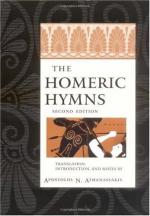American, and Australian “mediators” are
infinitely more akin to Apollo, in his relations with
Zeus and with men, than to any Person about whom missionaries
can preach. But the most devoted believer in
borrowing will not say that, when the Australian mediator,
Tundun, son of Mungun-gnaur, turns into a porpoise,
the Kurnai have borrowed from our Hymn of the Dolphin
Apollo. It is absurd to maintain that the Son
of the God, the go-between of God and men, in savage
theology, is borrowed from missionaries, while this
being has so much more in common with Apollo (from
whom he cannot conceivably be borrowed) than with
Christ. The Tundun-porpoise story seems to have
arisen in gratitude to the porpoise, which drives fishes
inshore, for the natives to catch. Neither Tharamulun
nor Hobamoc (Australian and American Gods of healing
and soothsaying), who appear to men as serpents, are
borrowed from Asclepius, or from the Python of Apollo.
The processes have been quite different, and in Apollo,
the oracular son of Zeus, who declares his counsel
to men, I am apt to see a beautiful Greek modification
of the type of the mediating Son of the primal Being
of savage belief, adorned with many of the attributes
of the Sun God, from whom, however, he is fundamentally
distinct. Apollo, I think, is an adorned survival
of the Son of the God of savage theology. He
was not, at first, a Nature God, solar or not.
This opinion, if it seems valid, helps to account,
in part, for the animal metamorphoses of Apollo, a
survival from the mental confusion of savagery.
Such a confusion, in Greece, makes it necessary for
the wise son of Zeus to seek information, as in the
Hymn to Hermes, from an old clown. This medley
of ideas, in the mind of a civilised poet, who believes
that Apollo is all-knowing in the counsels of eternity,
is as truly mythological as Dunbar’s God who
laughs his heart sore at an ale-house jest. Dunbar,
and the author of the Hymn, and the savage with his
tale of Tundun or Daramulun, have all quite contradictory
sets of ideas alternately present to their minds; the
mediaeval poet, of course, being conscious of the contradiction,
which makes the essence of his humour, such as it
is. To Greece, in its loftier moods, Apollo
was, despite his myth, a noble source of inspiration,
of art, and of conduct. But the contradiction
in the low myth and high doctrine of Apollo, could
never be eradicated under any influence less potent
than that of Christianity. {34} If this theory of
Apollo’s origin be correct, many pages of learned
works on Mythology need to be rewritten.
THE HYMN TO HERMES
[Hermes with the boy Dionysos. Statue by Praxiteles, found at Olympia: lang35.jpg]




